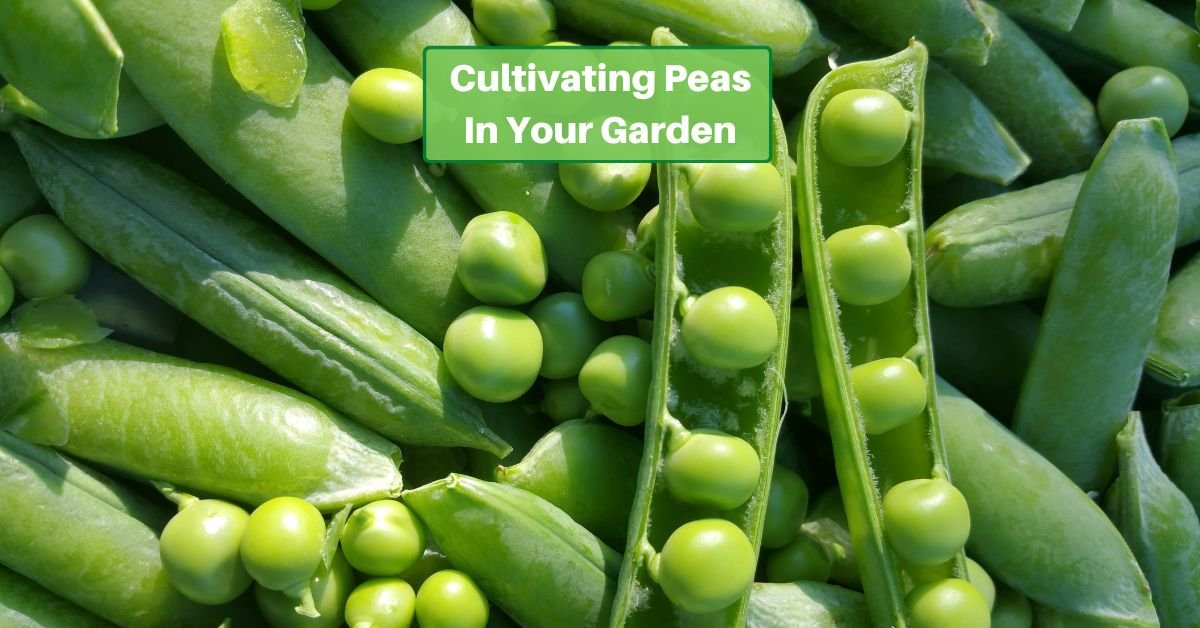Peas are a great addition to many home gardens. Their sweet taste and use in many popular dishes means they’ll always find a welcome spot on the table!
In this guide, we’ll walk you through everything you need to know to grow peas successfully.
Types of Peas
Before delving into the specifics of growing peas, it’s important to understand the different types of peas you can grow in your garden. The primary types of peas include:
- Garden Peas (Pisum sativum): These are the traditional, round peas that need shelling before consumption. They are also known as English peas and are popular for their sweetness and versatility in various dishes.
- Snap Peas (Pisum sativum var. macrocarpon): Snap peas are edible-podded peas. That means you can eat the entire pod. They are sweet with a crunchy texture and are excellent for snacking or adding to salads.
- Snow Peas (Pisum sativum var. saccharatum): Snow peas are another type of edible-podded pea. They are flat and thin. The pods are tender and sweet and are commonly used in stir-fries and salads.
Each type of pea has its unique characteristics and requirements, so it’s essential to select the variety that suits your gardening goals and individual tastes.
Planting Season
Peas are cool-season crops, and their ideal planting season depends on your local climate. In most regions, peas are planted either in early spring or late summer for a fall harvest. Here’s a general guideline for planting peas:
Early Spring Planting
Plant peas in early spring as soon as the soil is workable and the average temperature is consistently above freezing. This allows them to mature before the summer heat sets in.
Late Summer Planting
In areas with hot summers, consider planting a second crop of peas in late summer, around 8-10 weeks before the first expected fall frost. This allows for a fall harvest when the weather cools down.
Seeds vs. Seedlings
Peas are commonly grown from seeds directly sown in the garden. However, some gardeners prefer starting them indoors as seedlings and then transplanting them. Here’s a comparison:
- Seeds: Planting peas from seeds directly in the garden is the most straightforward method. Prepare the soil, sow the seeds, and provide proper care for germination and growth.
- Seedlings: Starting peas indoors can give you a head start in regions with short growing seasons. Plant seeds in biodegradable pots indoors about 4-6 weeks before your intended outdoor planting date. Transplant seedlings when they have several true leaves.
Order Pea Seeds Online
Soil and Fertilizer Requirements
Peas thrive in well-draining soil rich in organic matter. Here’s how to prepare your soil:
Soil Preparation
Work the garden bed to a depth of at least 6-8 inches. Remove weeds, rocks, and debris.
pH Levels
Peas prefer soil a little on either side of neutral. A pH as acidic as 6.0 or as alkaline as 7.5 is ideal. Test your soil and treat it with lime as needed to adjust pH.
Organic Matter
Adding compost to the soil will make it more fertile and help it retain moisture.
Fertilization
Peas typically don’t require heavy fertilization. Use a balanced, all-purpose fertilizer or a phosphorus-rich fertilizer to promote strong root development. Apply according to package instructions when planting.
Planting and Spacing
Planting peas correctly and providing adequate spacing is crucial for healthy growth and high yields.
Plant pea seeds about 1 inch deep. If planting in heavy soil or clay, consider planting them a bit shallower. If you’re going to plant multiple rows, space them about 18-24 inches apart. Leave 2-4 inches between each pea seed in a row.
Proper spacing ensures good air circulation, which is important for growth and disease control.
Care During Growth
Caring for your pea plants as they grow is essential for a fruitful harvest. Here’s what you need to do:
- Watering: Keep the soil moist but not waterlogged. Peas require about an inch of water per week. Water at the base of the plants to prevent fungal diseases.
- Mulching: Apply a layer of mulch around your pea plants to conserve moisture, suppress weeds, and keep the soil temperature stable.
- Support: Pea plants tend to climb, so give them support to prevent them from sprawling on the ground. Trellises, stakes, or pea netting are important to help them grow.
- Weed Control: Be sure to stay on top of weeds to reduce competition for nutrients and water.
Time to Maturity
The time it takes for peas to mature depends on the type of peas you’re growing and environmental conditions. Here’s a general guideline:
- Garden Peas and Snap Peas typically take 60-70 days to reach maturity.
- Snow Peas are often ready for harvest in 50-60 days.
However, these timelines can vary. Check the specific instructions on your seed packet for more accurate information.
Harvesting Peas
Knowing when and how to harvest peas is crucial for enjoying the best flavor and tenderness:
Harvest Time
When the pods are well-filled but still tender, it’s time to harvest your peas! Harvest garden peas when the pods are plump but the peas inside are not overly developed. Snap peas should be harvested when the pods are crisp and plump, while snow peas are best when the pods are flat and the peas inside are small.
Harvesting Technique
Gently grasp the pea pod and use your thumb and forefinger to snap it off the plant. Don’t twist or pull; that can tear the plant.
Regular Harvesting
Pea plants can produce more peas as long as you keep picking the ripe pods. So be sure to harvest peas regularly to get more production.
Growing peas can lead to a rich yield of pods in just about two months. No matter which type you favor, the satisfaction of eating peas from your own yard is fantastic. So, roll up your sleeves, get your hands in the soil, and start cultivating those tasty pods today!










